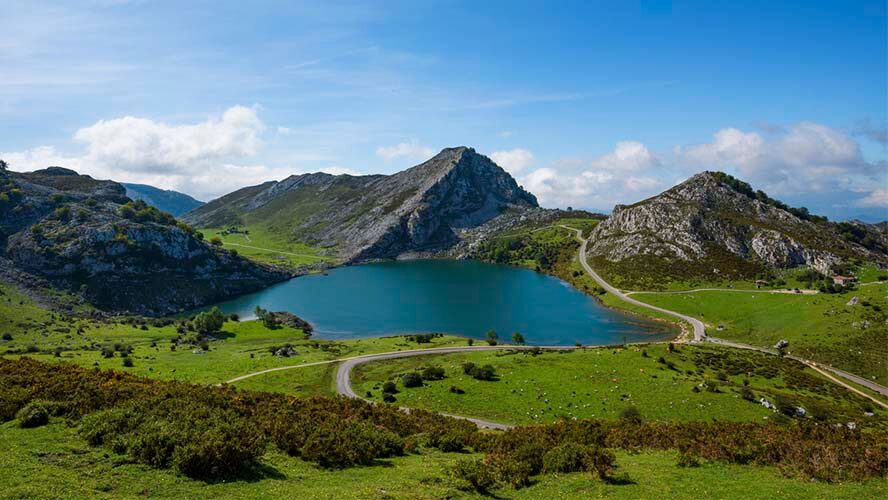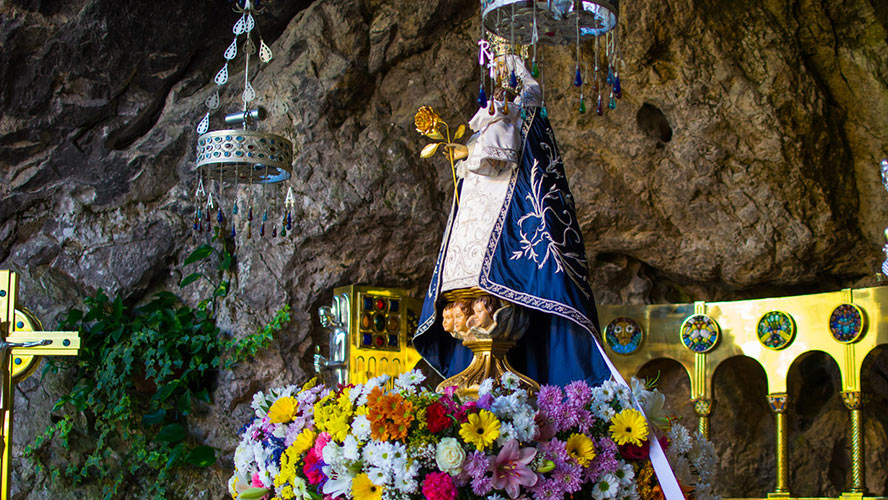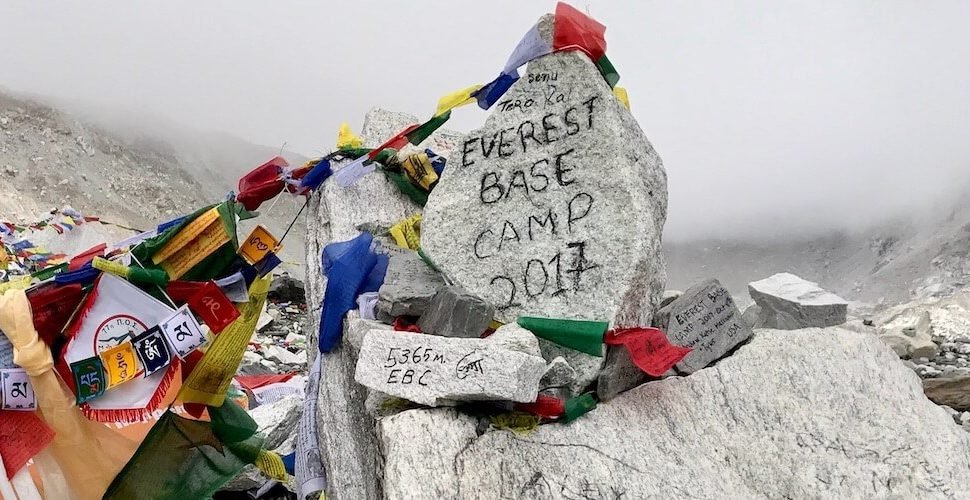The spiritual heart of Asturias
Art, heritage, landscape, history, worship… Covadonga has it all. The cave of La Santina, the neo-Romanesque basilica and the magnificent glacial lakes make this area an unmissable destination on a trip to Asturias.
If you drive your own car to Covadonga in high season, you must park in the designated parking lots. Shuttle buses will take you the rest of the short distance to the Príncipe Gardens, the Covadonga sanctuary and the lakes. The buses stop several times along the route.
What is there to see in Covadonga?
The sanctuary and the Santa Cueva
The Santa Cueva or ‘Holy Cave’ is located above a waterfall that forms a pool below the sanctuary. Next to it is the Fuente de los Siete Caños (Fountain of the Seven Gargoyles), also known as the ‘Marriage Fountain’, as popular belief has it that a young girl who drinks the water from the fountain without gasping for air will be married within a year. The verse reads as follows: ‘The maiden of Covadonga/ has a well so glassy,/ that any girl who drinks its water/ will be married within a year’.
Two large Carrara marble lions sit on either side of the road, guarding the entrance to the sanctuary. They are exact replicas of the sculptures by Pompeio Marchesi.
Entering the cave with the Virgin of Covadonga – the most venerated image in Asturias – is no great challenge. Simply climb the 103 steps of the Staircase of the Promise (some pilgrims do this on their knees). The cave can also be accessed from the esplanade of the basilica. Pilgrims come here to venerate la Santina, which is actually a copy of the original statue that was destroyed in a fire in 1777. The altar is decorated with images alluding to the Battle of Covadonga. Nearby are the tombs of Pelagius of Asturias and his wife Gauiosa, as well as those of his son-in-law Alfonso I and his daughter Hermelinda.
Next to the Santa Cueva is the monastery of San Pedro. It houses a community of canons and also has a house for spiritual practises.
Continue your journey with a visit to the Basilica of Covadonga. The construction of the building was entrusted to Federico Aparici y Soriano by Bishop Ramón Martínez Vigil of Asturias after the failed attempt by Bishop Benito Sanz y Forés. The work was completed in 1901 and the temple was given the status of a basilica by Pope Leo XIII. Its structure is reminiscent of Norman-Romanesque cathedrals: The façade has large twin towers and a portico with busts of the bishops who were responsible for building the basilica.
The Basilica of Covadonga is home to many works of art, including two paintings of the Annunciation by Vicente Carducho, the Annunciation of Pelagius by Luis de Madrazo and a sculpture of the Virgin and Child by Joan Samsó. Don’t forget to visit the 4,000-kilo, 3-metre-high bell that was cast in La Felguera in 1900.
The treasure of la Santina de Covadonga
After visiting the large monument erected in honour of King Pelagius, continue to the basilica museum, which is located in the former school building of the monastery. There is an interesting exhibition on the history of Covadonga, the historic battle, the construction of the basilica, royal visits, holy days and votive offerings, etc. The objects and offerings from the treasure of La Santina are also on display.
Conclude your visit to Covadonga at the Enol and La Ercina lakes. The lakes are located 12 kilometres from the sanctuary and the road is closed to private vehicles in high season. To reach the lakes, take one of the shuttle buses that leave every 10 minutes from the train station in Cangas de Onís. They stop at several points along the route.
Hiking at the Covadonga lakes
With several routes to choose from, this is a hiker’s paradise. If you are short on time, you should at least walk the circular route between the two lakes (approx. 1 hour).
Lake Ercina is 1,108 metres above sea level, muddy and teeming with aquatic life. Lake Enol lies at 1,060 metres and is 23 metres deep. In contrast to its brother, the clear water of this lake is lifeless. If you have time, head to the Interlagos viewpoint for a spectacular view of these two crystal-clear lakes. On September 8, visitors to the area can enjoy the annual Fiesta Mayor in honour of the Virgin of Covadonga.

The Virgin of Covadonga: a long history
Covadonga is said to have already had a chapel in the Middle Ages, although the veneration of the ‘Virgin of Battles’ only became widespread after King Pelagius’ victory over the Muslims. Initially, a Benedictine monastery was built, with the church of Santa María in the cave. Felipe IV later founded a collegiate church of San Agustín.
In October 1777, the church in the Santa Cueva was engulfed by fire. Some say it was caused by a lightning strike, others blame the large candles that pilgrims had lit. The fire destroyed the wooden chapel and the statue of La Santina, along with all its treasures and sacred decorations.

After the news reached King Charles III of Spain, he ordered the construction of a new monumental temple. He sent his court architect Ventura Rodríguez to design a great national shrine.
Work on the new basilica took place between the late 19th and early 20th centuries. It bears a certain resemblance to the Pena Palace in Sintra (Portugal) and Neuschwanstein Castle in Bavaria (Germany). The image of the Virgin was crowned on September 8, 1918 by the Archbishop of Toledo in the presence of King Alfonso XIII and Queen Victoria Eugenia.
Historical tidbit: Between 1908 and 1933, a steam streetcar ran between Arriondas and Covadonga.
The banishment of La Santina
The statue of La Santina was stolen in 1939 and taken to Paris during the Spanish Civil War. History does not suggest that the statue was desecrated. Instead, it was held hostage in the hope of gaining a high military or political rank in exchange for its release. However, the exchange never took place. The polychrome wooden painting was found by chance after the war by the Spanish ambassador in Paris, Pedro Abadal. Without wasting any time, the ambassador reported his find and crossed the Spanish border with the statue in his own car to ensure it was safely returned to its rightful place in the chapel in the Santa Cueva.
Here are some other important dates in the history of Covadonga: in 1954, Cardinal Roncalli (later Pope John XXIII) prayed at the Santina; Pope John Paul II did the same in 1989; Spain’s current King Felipe IV was proclaimed Prince of Asturias at this site in 1977.
Mount Rysy (2,503m) is a fantastic and unique peak in the High Tatras. Rysy is the highest mountain in the…

Multi-activity winter holiday in the Slovakian High Tatras.

Do you want to start your adventure with winter hiking in the Tatra Mountains? Do you care about safety? The Winter Tourism course is just for you! Here you will learn everything necessary and gain practical skills that will allow you to go to the Tatra Mountains in winter. No more waiting for summer! Be brave and experience the charm of the mountains in the winter aura!





